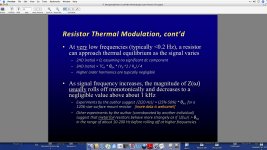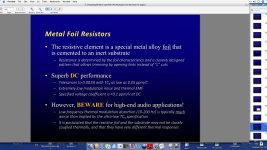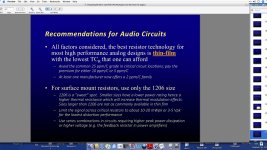pulling up a old Michael Percy catalog I see 50 ppm Holco, Roederstein, Caddock film resistors being pitched to audiophiles along with the "naked Vishay"
seems like "respected by golden ears" doesn't exactly follow Hofer's findings for lowest distortion
those Holco are even worse than Bruce's "avoid the common 25 ppm/C grade in critical circuit locations..."
curious minds?
seems like "respected by golden ears" doesn't exactly follow Hofer's findings for lowest distortion
those Holco are even worse than Bruce's "avoid the common 25 ppm/C grade in critical circuit locations..."
curious minds?
Last edited:
Like it mattersIf one relies on tceff of resistors in a design for audible effect, surely the design would be considered suspect in most schools.....
It's designing OUT nonlinearity by careful component choice. These are important when you're down in the <-100 dB range. In an absence of numbers, it's hard to know how large this effect is (conceivably way below hearing threshold, especially since it's material at larger voltage swings (masking, anyone?)
Exactly. I suppose it's conceivable to design something so unstable as to audibly depend upon it, but mostly it has to be fantasy....conceivably way below hearing threshold
Use Dale everybody!
Fine by me, funny how all the thin film resistors in IC's are a few 100 atoms thick and you could put 1000's of them in the volume of an 1206 SMT. Every AP has dozens.
So now you're attributing the chase for numbers as the road to good sound, Bruce is talking that -120db spec stuff not anything remotely audible?
Last edited:
It is NOT harmonic distortion itself that we look for. More, DYNAMIC resistance changes.
Still ppm's or fractions of a ppm, the stationarity of a typical listening environment swamps this. That is I defy you to measure the frequency response or distortion of any speaker in any room to the ppm level from one minute to the next.
It is NOT harmonic distortion itself that we look for. More, DYNAMIC resistance changes.
It is NOT audio that we look for, it's mystic.
Bruce's Equipment can test things so we can then listen to them don't listen to an Ap, well except sometimes the head phone out.
I repaired and calibrated one of our Ap ones since they aren't supported any more and all six are still testing today. A fabulous piece of brilliance and engineering!
I repaired and calibrated one of our Ap ones since they aren't supported any more and all six are still testing today. A fabulous piece of brilliance and engineering!
Still ppm's or fractions of a ppm, the stationarity of a typical listening environment swamps this. That is I defy you to measure the frequency response or distortion of any speaker in any room to the ppm level from one minute to the next.
Scott,
You might want to actually read the current presentation. Then we can talk about what distortion means. Low order harmonic distortion isn't that important. High order and non harmonic distortions really stand out.
I just love how he is now pointing to dC/dT as significant. That produces artifacts that can be totally unrelated to the signal.
Now the slides didn't get into dielectric absorption other than a touch on using capacitors at a fraction of rated voltage. And that clears up most dielectric issues.
He also covers things like power supply transients and loop area. But I didn't see any mention of why that also influences component selection. The thin film chip resistors also help decrease loop area.
It is NOT harmonic distortion itself that we look for. More, DYNAMIC resistance changes.
Many parameters change under voltage and current and freq and fields. About one hundred years ago (or was it 40?) I checked this issue of Volt Coeff and thermal as well...... I took a PA circuit with 100K fb resistor. it was worse than 100ppm but lets use that..... with +/- 50 v peak (100v p-p) across it, that would be an R change of only 10 Ohms......for one volt.... or about 1000 Ohms dynamic change at 100v. The Vas stage can have similar values and voltages as well as other places and circuits. Converted into gain dB's it is a tenth here and a tenth there. The over-all accumulated affect is less clarity in the micro-details of the music signal. So, yes, use <10ppm resistors and keep the voltage drop across them to low levels.
It really is all in the details now.
THx-RNMarsh
Last edited:
Use Dale everybody!
Actually, I intuitively tend to do just that. It goes back to version of a phono RIAA stage in which I took out its original 1% metal film (of unknown source) and replaced them with Dale resistors of the same value. I had a vague feeling that it sounded a bit better, a bit clearer than before. Next, I purchased a discrete resistor volume pot from Australia, and after comparing it with my "standard issue" ALPS Blue pots found that the improvement difference was more than a nagging feeling. I can't say I was bathed in holy light of revelation, but the difference was definitely there. And I do not posses "golden ears" by any means, I'm just a regular joe. who tends to stick to Beyschlag resistors and off-the-shelf devices.
Dynamic resistance changes due to thermal effects would show up in very closely spaced IM measurements. Almost certainly too small to be audibly relevant, but an issue for test equipment designers?john curl said:It is NOT harmonic distortion itself that we look for. More, DYNAMIC resistance changes.

Many parameters change under voltage and current and freq and fields. About one hundred years ago (or was it 40?) I checked this issue of Volt Coeff and thermal as well...... I took a PA circuit with 100K fb resistor. it was worse than 100ppm but lets use that..... with +/- 50 v peak (100v p-p) across it, that would be an R change of only 10 Ohms......for one volt.... or about 1000 Ohms dynamic change at 100v. The Vas stage can have similar values and voltages as well as other places and circuits. Converted into gain dB's it is a tenth here and a tenth there. The over-all accumulated affect is less clarity in the micro-details of the music signal. So, yes, use <10ppm resistors and keep the voltage drop across them to low levels.
It really is all in the details now.
THx-RNMarsh
Those `super critical` resistors which are stressed with high AC or DC voltages across ends have to be divided at least in four connected in series , for example ,
that 100K Rfb res. have to be replaced with four 25K res.connected in series.
- Status
- Not open for further replies.
- Home
- Member Areas
- The Lounge
- John Curl's Blowtorch preamplifier part II



